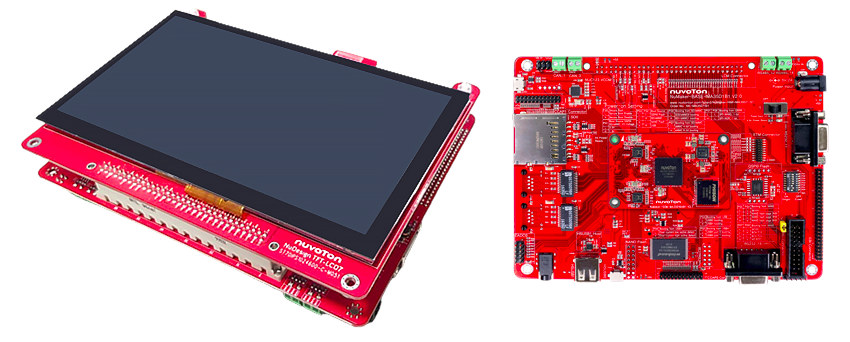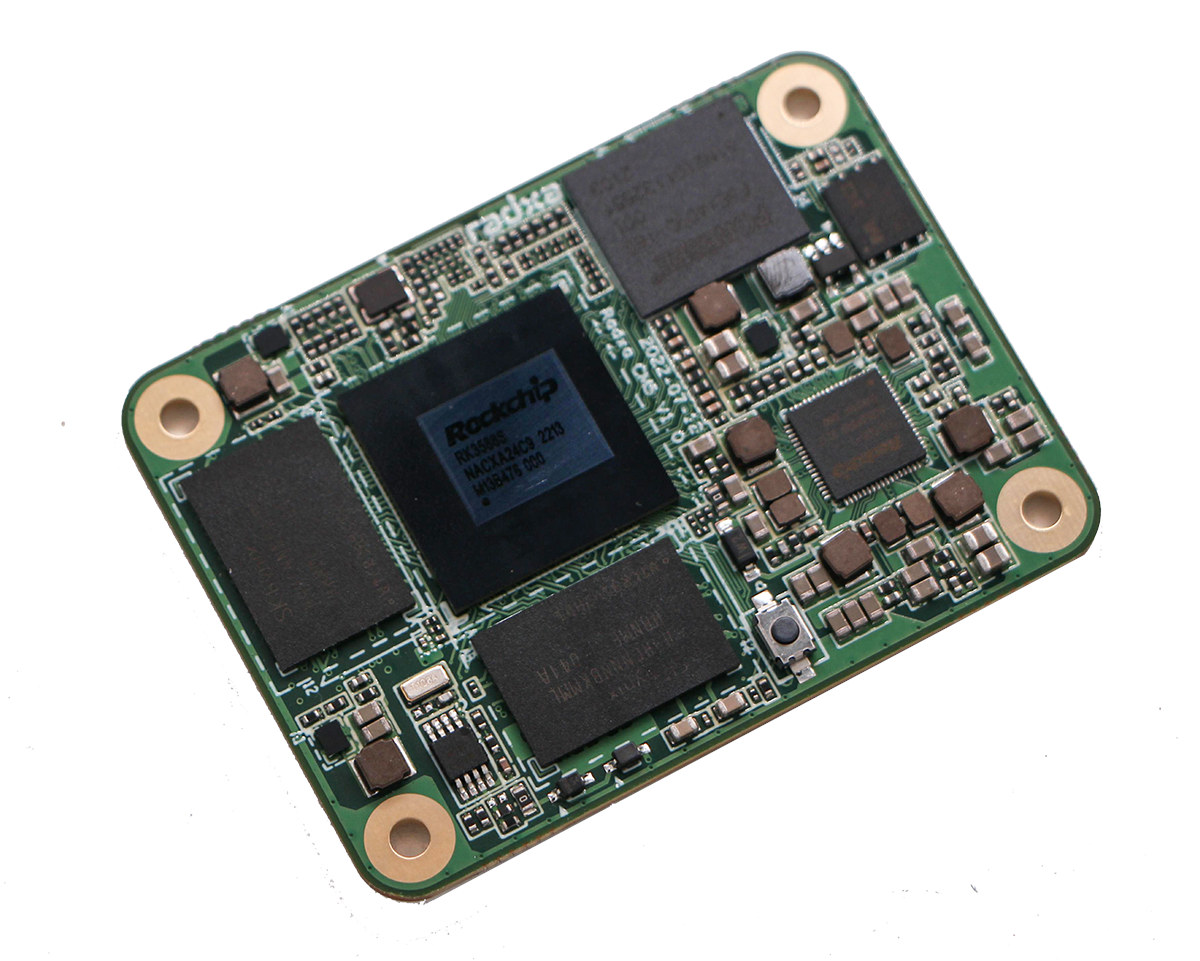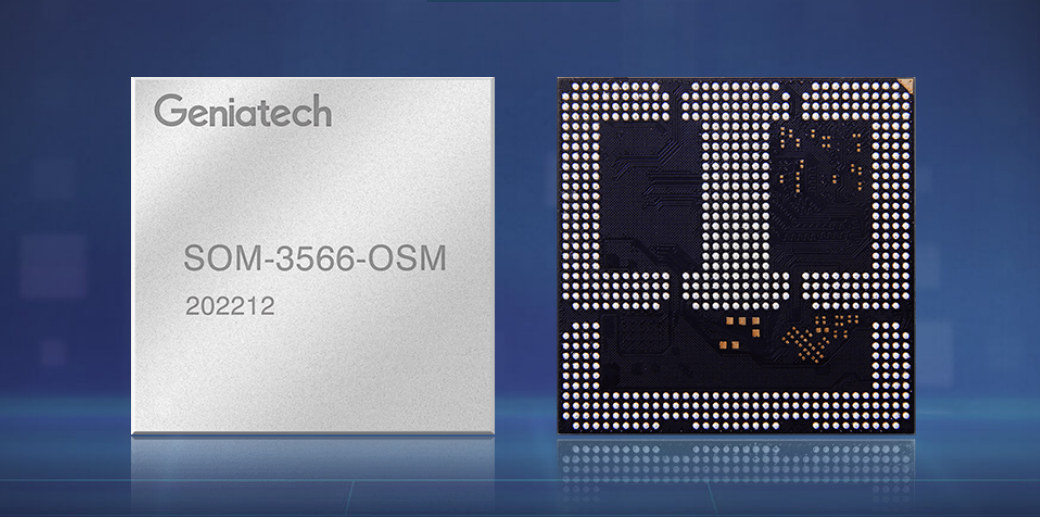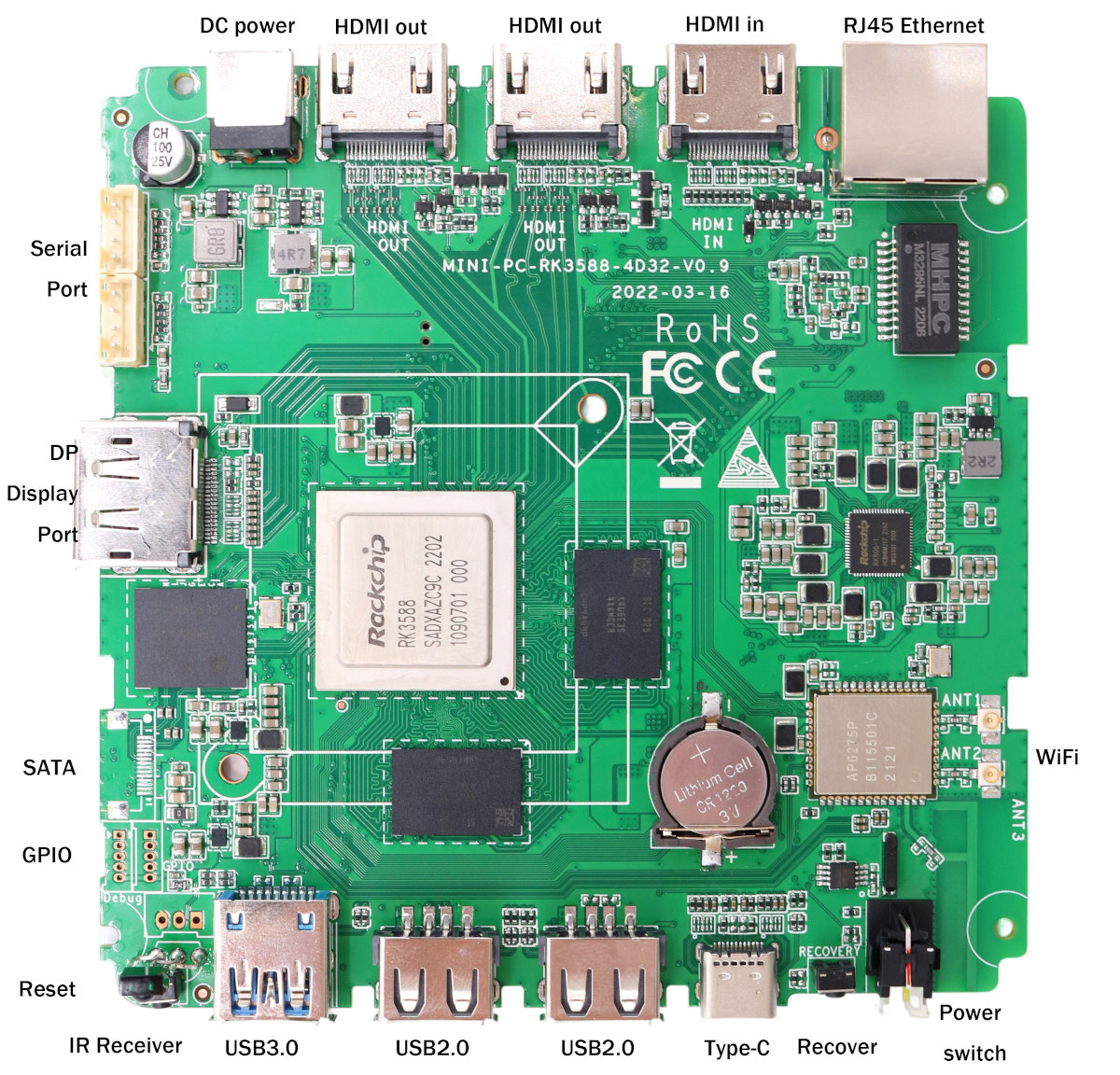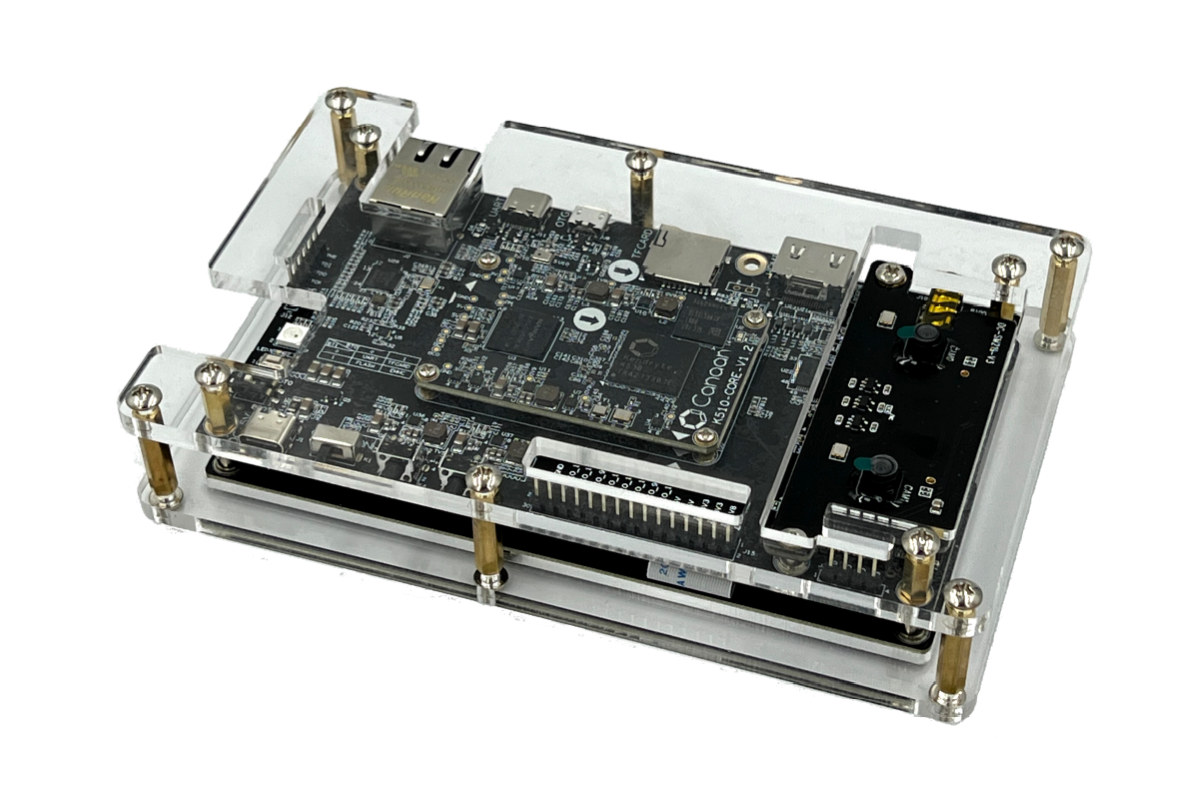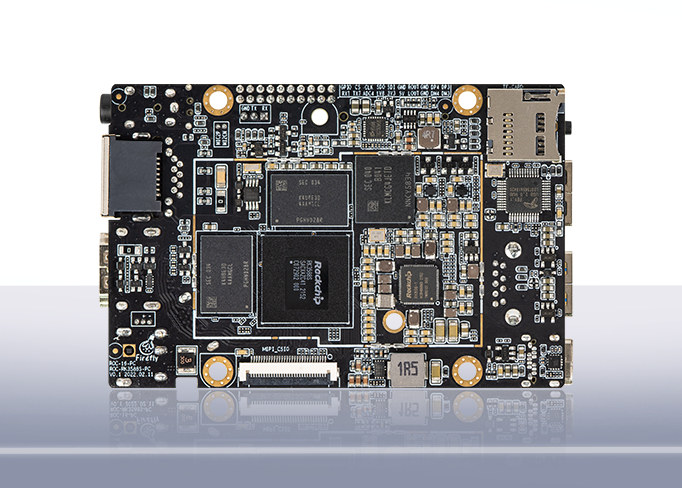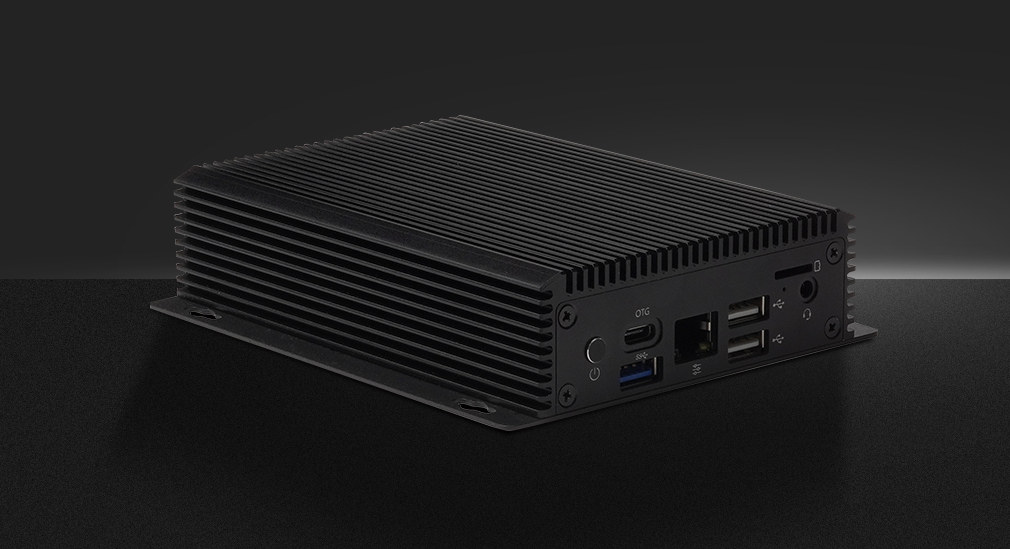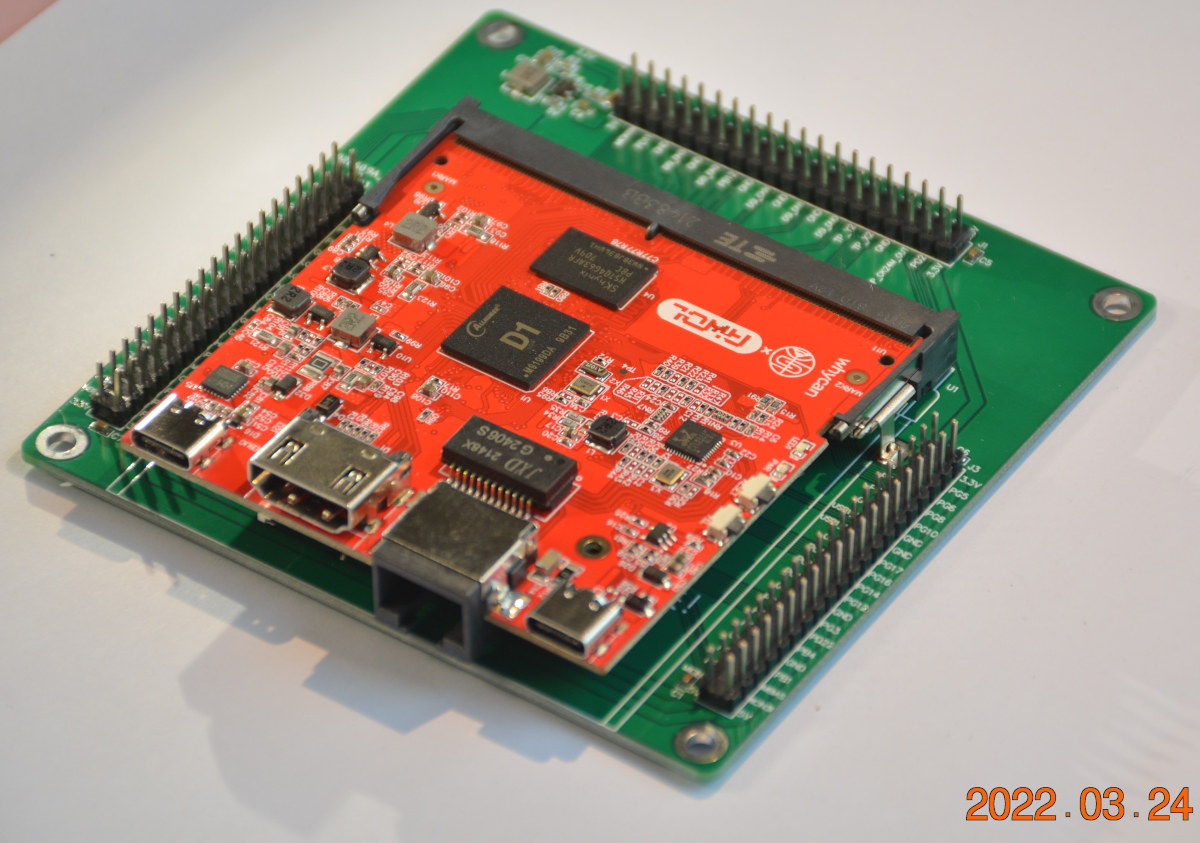Novoton NuMicro MA35D1 microprocessor features two Arm Cortex-A35 cores, one Arm Cortex-M4 real-time core, and two Ethernet interfaces for Linux-based edge IIoT gateway. The SoC also is offered in variants supporting external DDR memory or integrated up to 512MB RAM, 154 or 208 GPIOs, and an optional “Enhanced ADC”. The MA35D1 also comes with a TFT interface for up to 1920×1080 displays, several hardware security features, and the company says the microprocessor facilitates Tiny AI/ML for edge computing despite not integrating an AI accelerator. Nuvoton NuMicro MA35D1 key features and specifications: CPU sub-system 2x Cortex-A35 cores running at up to 800 MHz Cortex-M4 real-time core at up to 180 MHz Memory sub-system On-chip 384 KB SRAM (Cortex-A35 256 KB + Cortex-M4 128 KB) Multi-Chip Package (MCP) DDR up to 512MB External DDR interface for MA35D16A087C SKU Storage Quad SPI NAND Flash Controller Secure Digital Host Controller (SDHC) Display and Video […]
Radxa CM5 – A Rockchip RK3588S module (somewhat) compatible with Raspberry Pi CM4
Radxa has been working on the ROCK 5 Compute Module (aka Radxa CM5) system-on-module compatible with Raspberry Pi CM4, but based on the more powerful Rockchip RK3588S octa-core Cortex-A76/A55 SoC. Just like the Raspberry Pi Compute Module 4, it comes in a 55 x 40mm form factor, but instead of just two high-density 100-pin board-to-board connectors, the module includes three to cater for the additional I/Os from the Rockchip processor, just like they did for the Radxa CM3 equipped with a Rockchip RK3566 processor. Radxa CM5 specifications: SoC – Rockchip RK3588S octa-core processor with 4x Cortex‑A76 cores @ up to 2.4GHz, 4x Cortex‑A55 core @ 1.8GHz Arm Mali-G610 MP4 “Odin” GPU Video decoder – 8Kp60 H.265, VP9, AVS2, 8Kp30 H.264 AVC/MVC, 4Kp60 AV1, 1080p60 MPEG-2/-1, VC-1, VP8 Video encoder – 8Kp30 H.265/H.264 video encoder 6 TOPS NPU System Memory – 4GB, 8GB, or 16GB LPDDR4x‑4224 SDRAM Storage – Optional 8GB, […]
Geniatech launches OSM Size-L modules with Renesas RZ/G2L, Rockchip RK3566
Geniatech has introduced LGA system-on-modules compliant with the SGET OSM (Open Standard Module) Size-L standard and designed to be soldered directly on the carrier board. Two models have been launched with the SOM-G2L-OSM equipped with Renesas RZ/G2L Arm Cortex-A55/M33 processor, and the SoM-3566-OSM powered by a Rockchip RK3566 quad-core Cortex-A55 SoC. SOM-G2L-OSM module Specifications: SoC – Renesas RZ/G2L dual-core Cortex-A55 processor, Cortex-M33 real-time core, Arm Mali-G31 GPU, H.264 video encoder/decoder System Memory – 1GB RAM (2GB/4GB optional) Storage – 8GB eMMC flash (16GB/32GB optional) 662 contacts with Display – 1x MIPI DSI, 1x RGB Camera – 1x MIPI CSI Audio – I2S Networking – 2x Gigabit Ethernet USB – 1x USB OTG 2.0, 1x USB 2.0 host Serial – 2x CAN bus SDIO 3.0 Low-speed I/Os – 5x UART including debug, 2x I2C, 3x SPI, 3x PWM, 16x GPIO, 2x ADC Dimensions – 45 x 45 mm (OSM Size-L form […]
Mekotronics R58 is a cost-optimized Rockchip RK3588 SBC going for $169 and up
Mekotronics R58 is a single board computer based on Rockchip RK3588 processor that will also be sold as a mini PC with an enclosure, and offers a cheaper alternative to the company’s R58X embedded mini PC with up to 16GB RAM, dual Gigabit Ethernet, dual SATA, etc… The R58 comes with fewer ports notably only one Gigabit Ethernet port, one SATA interface, and the RS485/RS232 terminal block and M.2 socket are gone, but it does add an extra HDMI output port, meaning it could support up to four independent displays. It still features up to 16GB RAM and 64GB eMMC flash. Mekotronics R58 specifications: SoC – Rockchip RK3588 octa-core processor with four Cortex-A76 cores @ 2.4 GHz, four Cortex-A55 cores @ 1.8 GHz, an Arm Mali-G610 MP4 GPU, a 6TOPS NPU, 8K 10-bit decoder, 8K encoder Memory & eMMC flash configurations 4GB LPDDR4x + 32GB eMMC flash 8GB LPDDR4x + […]
Canaan K510 CRB RISC-V AI development kit ships with dual-camera module and LCD display
Last summer, Canaan introduced the Kendryte K510 tri-core RISC-V AI processor, now also known as Canaan K510, as an updated version of the Kendryte K210 with a much higher 3 TOPS of performance, but at the time, there were no development board and SDK. But I’ve now just been informed of the availability of the Canaan Kendryte K510 CRB (customer reference platform) AI development kit with camera module and LCD display, as well as a software development kit with U-Boot, Linux, and AI tools which can be used to develop smart audio and computer vision applications. Kendryte K510 CRB-Kit development kit specifications: SoC – Canaan Kendryte K510 dual-core RISC-V64 CPU up to 800MHz and 1x RISC-V DSP up to 800MHz for up to 3 TOPS AI performance, ultra-low-power wake-up VAD, H.264 video encoding up to 2 channels @ 1080p60 System Memory – 512 MB LPDDR3 @ 1600 MHz Storage – […]
ROC-RK3588S-PC is the first Rockchip RK3588S SBC, supports up to 32GB RAM
Rockchip RK3588S processor, a cost-down version of Rockchip RK3588 SoC with fewer interfaces, has made its way into Firefly ROC-RK3588S-PC SBC (single board computer) about the size of a credit card and equipped with up to 32GB RAM. The compact SBC also comes with up to 128GB eMMC flash, and offers support for NVMe storage, up to four video outputs through HDMI, USB-C and MIPI DSI interfaces, Gigabit Ethernet, USB 3.0, two MIPI CSI camera interfaces, and more. Firefly ROC-RK3588S-PC specifications: SoC – Rockchip RK3588S octa-core processor with 4x Cortex-A76 cores @ up to 2.4 GHz, four Cortex-A55 cores, Arm Mali-G610 MP4 quad-core GPU with OpenGL ES3.2 / OpenCL 2.2 / Vulkan1.1 support, 6 TOPS NPU, and an 8Kp60 H.265/VP9/AVS2 video decoder, 4Kp60 decoder, 8Kp30 H.265/H.264 video encoder System Memory – 4GB, 8GB, 16GB or 32GB LPDDR4/LPDDR4x/LPDDR5 Storage 16GB, 32GB, 64GB, or 128GB eMMC flash M.2 (PCIe 2.0) socket for […]
EC-R3568PC is a compact rugged mini PC based on Rockchip RK3568 SoC
Firefly EC-R3568PC is a compact rugged mini PC powered by Rockchip RK3568 SoC with a built-in 1 TOPS AI accelerator, up to 8GB RAM, 128GB flash, M.2 NVMe and SATA 3.0 storage, dual Gigabit Ethernet, HDMI 2.0 output, RS232 and RS485 interfaces through an RJ45 socket, and more. The fanless embedded computer is designed to be wall-mounted, and operates in a wide -20°C – 60°C temperature range making it suitable for smart NVR, cloud terminal, IoT gateway, and industrial control applications. EC-R3568PC specifications: SoC – Rockchip RK3568 quad-core Cortex-A55 processor @ up to 2.0GHz with Arm Mali-G52 2EE GPU with support for OpenGL ES 1.1/2.0/3.2, OpenCL 2.0, Vulkan 1.1. 1 TOPS NPU, VPU with 4Kp60 H.265/H.264/VP9 video decoding, 1080p60 H.265/H.264 video encoding System Memory – 2GB, 4GB, or 8GB LPDDR4 Storage 16GB, 32GB, 64GB, or 128GB eMMC flash 16MB SPI Flash M.2 PCIe 3.0 socket for 2242 / 2280 NVMe […]
Dongshan Nezha STU devkit features Allwinner D1 RISC-V SoM/SBC
Dongshan Nezha STU is a development kit comprised of an Allwinner D1 RISC-V system-on-module (SoM) and a carrier board with three 40-pin headers to access I/Os from the RISC-V processor. While not quite as compact as the Sipeed LicheeRV module, the “Dongshan Nezha STU Core” module also doubles as a standalone single board computer (SBC) with USB-C, Ethernet and HDMI ports, plus a MicroSD card socket for the firmware, which reminds me of the Khadas Edge design. Dongshan Nezha STU specifications: Nezha STU Core SoM SoC – Allwinner D1 single-core XuanTie C906 64-bit RISC-V processor @ 1.0 GHz with HiFi4 DSP, G2D 2D graphics accelerators Memory – 512MB DDR3 memory (option up to 2GB – TBC) Storage – MicroSD card slot, 2Gbit serial NAND flash (MX35LF1GE4AB); Note the SPI NAND flash (U12) is not populated in the photo below. Video – HDMI port up to 1080p60 Networking – Low-profile Gigabit […]


